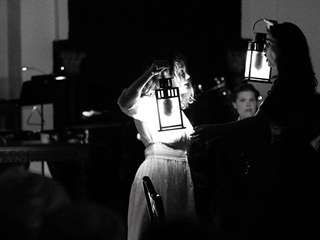|
Back
On Site Opera Takes Britten on Location New York
Wave Hill
10/27/2019 - & October 28, 29*, 2019
Benjamin Britten: The Turn of the Screw, Op. 54
Jennifer Check (Governess) Dominic Armstrong (Peter Quint), Adriana Zabala (Miss Jessel), Margaret Lattimore (Mrs. Grose), Ashley Emerson (Flora), Jordan Rutter (Miles)
Americana Ensemble: Sato Moughalian (Flute), Keve Wilson (Oboe), Pascal Archer (Clarinet), Charles McCracken (Bassoon), Kyle Hoyt (Horn), Katie Andrews (Harp), Jonathan Heaney (Piano, Celesta), Clara Warnaar (Percussion), Max Moston, Victoria Paterson (Violin), Philip Payton (Viola), Dave Eggar (Cello), Roger Wagner (Bass), Geoffrey McDonald (Music Director)
Eric Einhorn (Stage Director), Amanda Seymour (Costume Designer), Shawn K. Kaufman (Lighting Designer)

(© Pavel Antonov)
On Site Opera takes over the main house and grounds of Wave Hill for a splendid production of Benjamin Britten’s The Turn of the Screw. The Wave Hill Estate in New York has been occupied by Mark Twain, US President Theodore Roosevelt as a boy, and Arturo Toscanini among others. Now the family of Miles and Flora and their retinue, alive and perhaps ghostly, occupy Wave Hill.
In the Henry James’ novel on which the opera is based, the setting is a country estate, Bly. Rain on October 29, prevented audience from wandering the grounds with lanterns as planned. Instead, the prologue was performed on the main house terrace, where we awaited a new Governess’ arrival.
Jennifer Check, singing the role of the Governess, tipped off a few changes made in the work. She joined the prologue singer in the phrase, And “I will, she said.” Percussion interludes are added to move the cast and audience from one location to another. Percussionist Clara Warnaar kept the beat steadily moving forward, adding chimes and rattles when required.
We are entering a private space, the heartland of sexuality. The outside world impinges briefly yet significantly when Miles is kicked out of school for ˜corruption.” Mention is also made of the children’s distant London guardian, who interviewed the Governess for a job in which he curiously wanted no part, not even supervisory by letter. When Miles and Flora first enter singing nursery rhymes, Miles is dragging his sister, legs sprawled wide and receptive. A ghost touches Miles’ private parts, in fantasy or reality, depending on your perspective. Inside is our focus.
Ms. Check has a rich voice, which she uses to indicate her appreciation of the beautiful settings. She caresses the wood of a royal purple velvet armchair with a sexual gesture. Eroticism is introduced throughout by the director, Eric Einhorn. Henry James had spoken about two stories being told: one, the wakening sexuality of the two children who are living at Bly, and the other, the mounting hysteria of the Governess as she confronts ghosts from Bly’s past, particularly Peter Quint who may have seduced the boy. At the very least. In the Governess’ mad imagination, we see Quint touch the boy Miles’ genitals. To support the first story, we see and hear the children’s teasing nursery rhymes in carnal mode.
Crescendoing in anxiety, gifted conductor Geoffrey McDonald brings forth Britten’s subtle yet often highly dramatic music. Rightly called a masterpiece, instrumentation is evocatively tailored to character and mood.
The entire cast is masterful. Dominic Armstrong as Quint stands out from the moment he is introduced with a celesta flourish. The harp tremulandos, celesta arpeggios, gong strokes and horn which precede his first scene with the boy Miles are exotic, like the real relationship or fantasy is.
We moved into main room, high ceilinged with arched windows facing each and west and north. The sun is setting. The room goes dark. The mood goes darker as the Governess is overtaken by mad thoughts.
Although the work in general follows the James’ story, new scenes are revelatory. Miles’ Malo is an obsessive tune, with a triadic harp and plaintive viola/horn in countermelody. Rising melodic figures suggest sexual pleasure. Downward turns feel like disgust. Questioning interjections of the horn are both obsessive and sad. So too the pedal of the viola. Miles’ melody also suggests the Governess opening the expulsion letter from the school and also the flourish indicating Quint’s presence. The audience, but not the opera’s characters, look up to a high balcony where Quint appears, Juliet-like, the lover. McDonald conducts to make sure that we hear the Malo melody casting its shadow over the rest of the score.
The scenes added in Act II make the ghosts’ presence palpable to the audience, because they are real for the Governess and, through her, to the children. We also get an intense feeling of claustrophobia from the music, even though we are in a wide open room, with a very high ceiling. Check creates this ever tightening mood for us. In her facial expressions of horror, and in her terrified motions, she takes us on the journey of her hysterical reaction to the children’s emerging sexuality and the influence of a past governess Miss Jessel and Quint.
An ambiguous theme consisting of three four-note phrases pervades the work. While we may not identify the two keys of the piece, A major for the Governess and A flat for the ghosts, we are often tantalizingly disturbed by the closeness of these two notes and keys.
On Site immerses us in this rich work, bringing the huge dramatic voices up close and personal and also by including us on a stage in a setting similar to the original work’s.
Susan Hall
|